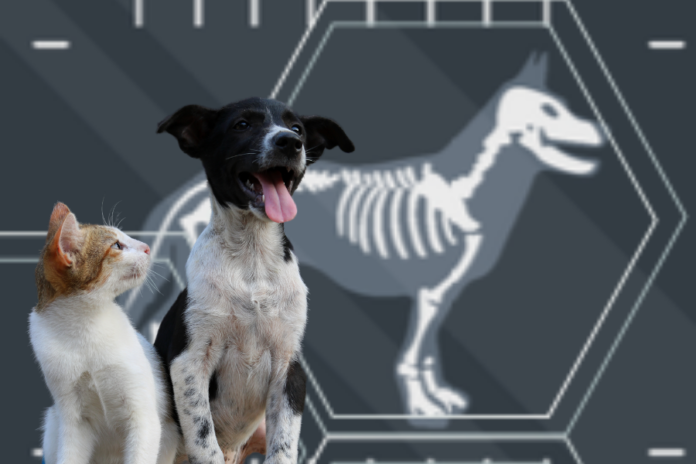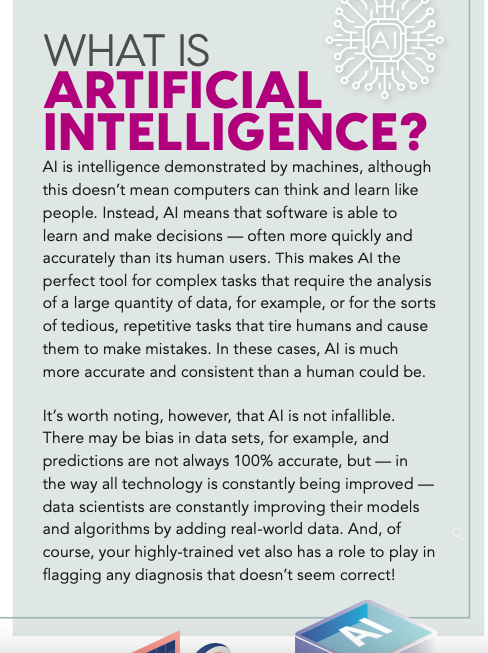AI helps your veterinarian provide optimal care for your dog or cat

Artificial intelligence (AI) is a valuable tool that can help your veterinarian do her job with greater speed and precision, freeing her up to focus on complex tasks and concentrate on the welfare of your dog or cat.
Artificial intelligence (AI) is fairly new to the animal health sector. Over the past decade, however, researchers, scientists, and entrepreneurs have begun to introduce machine learning and AI into veterinary health, with groundbreaking results. Of course, nothing can replace the expertise of a good veterinarian when it comes to diagnosing and treating diseases in animals. What AI does is help streamline your vet’s job, and that gives her more time and freedom to devote to your dog or cat’s well-being. Let’s look at how AI is used in veterinary settings, and how it positively impacts your dog or cat.
HOW DO VETERINARIANS USE AI?
Imaging
Animals always need x-rays, but there are currently not enough veterinary imaging professionals to take and interpret those images. While teaching staff in universities have been hardest hit by the shortage, even lucrative private veterinary practices are struggling to find and keep veterinary radiologists. AI can fill the gap left by these shortages.
 The good news is that AI products are available to interpret x-ray images. They involve cloud-based software that uses AI to read x-rays and interpret them quickly and inexpensively; your vet accesses it by signing into a website and uploading images. The results come back almost immediately so your vet can move on with the process of diagnosis and treatment.
The good news is that AI products are available to interpret x-ray images. They involve cloud-based software that uses AI to read x-rays and interpret them quickly and inexpensively; your vet accesses it by signing into a website and uploading images. The results come back almost immediately so your vet can move on with the process of diagnosis and treatment.
AI is extremely well suited to radiology because pictures really do contain a thousand words. X-rays are filled with data, and AI is able to quickly compare previous and current images, prioritize the data, and analyze images. Veterinary radiologists are still needed to read complex images, but
AI can streamline the analysis process, filtering out mundane and uninteresting x-rays so that veterinarians can concentrate on the images that most need attention and the expertise of a trained clinician.
Data analysis
Thanks to continuous improvements in modern medicine, veterinarians are inundated with data from devices, software, and other sources. While more is certainly better, it can also be overwhelming; large datasets are difficult for humans to read. They also might contain irrelevant data or false patterns. Also, when faced with a firehose of data, a human being is likely to miss the big picture. Not so with AI, which never tires, and can sift through large quantities of data to find complex patterns, unprecedented correlations, or small abnormalities humans cannot see.
For example: Consider some recent work done by veterinarians at the University of California, Davis School of Veterinary Medicine, who worked with a computer engineer to develop an algorithm tasked with finding Addison’s disease in dogs. Addison’s is a rare disorder, potentially fatal because it mimics the symptoms of other diseases. This means it’s often misdiagnosed, going undetected and untreated for years. Dogs with Addison’s present with vague symptoms that look like other conditions, such as kidney and intestinal disease.
Normally, when a sick patient first visits the vet, routine blood tests are ordered — a complete blood count and serum biochemical profile. Because Addison’s patients lack critical hormones, their tests often come back with subtle irregularities that are frequently confused with other conditions. The UC Davis team’s algorithm uses AI to analyze blood work data and detect complex patterns unique to Addison’s. The researchers used the test results of 1,000 dogs to train their algorithm to detect the patterns that signal Addison’s. The algorithm functions as an alert system, using information from routine screening tests to flag patients in which Addison’s disease is likely, and inform your veterinarian that further investigation is necessary. It has been 99% effective in diagnosing new patients.
Diagnosis and prediction
When it comes to life-threatening diseases, it is critical
to catch them before they develop. This may sound impossible, but with the right data, vets can make educated predictions about which animals will develop a disease.
Chronic kidney disease (CKD) in cats is a good example — it’s not reversible, and often, by the time it presents, the patient has already suffered kidney damage. It also tends to affect older cats, so by the time a veterinarian catches a case of CKD, the cat’s quality of life is likely to be severely impacted. If the occurrence of CKD can be predicted, however, the patient can be treated before kidney damage occurs, and the cat’s health and quality of life can be dramatically improved.
For example: Researchers recently developed an algorithm to predict CKD before a cat gets sick. It uses AI to predict whether a cat will develop the disease. Trained on Electronic Health Records (EHR) from
20 years of vet visits, the algorithm looked for specific factors that contributed to CKD in more than 100,000 cats across breeds, geographical areas, and ages from one year old to more than 22.
Using this dataset, the team built a recurrent neural network (RNN) that examines blood work for four factors contributing to CKD: creatinine, blood urea nitrogen, urine specific gravity, and age. The RNN was able to predict whether a cat will develop CKD within the next two years with greater than 95% accuracy. The false positives were very low — a huge benefit for vets who have traditionally dealt with CKD as a difficult-to-detect disease. This model can quickly be implemented in hospital practice or diagnostic laboratory software to directly support veterinarians in making clinical decisions regarding sick cats.
It’s important to remember that while AI is excellent at crunching numbers and digesting a large amount of data quickly, it doesn’t do well at some of the tasks at which humans excel. Creativity, problem-solving without a defined training dataset, and of course, bedside manner, are all human skills that AI cannot duplicate. For this reason, AI is an excellent partner to your veterinarian. By taking the pressure of diagnosis, prediction, or data analysis off the vet, AI allows her to really focus on your dog or cat’s health problems, decide on courses of treatment, and make sure he has the best quality of life possible.



